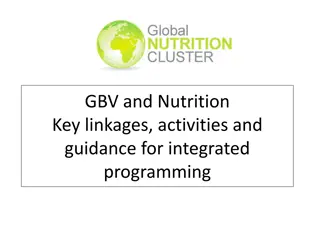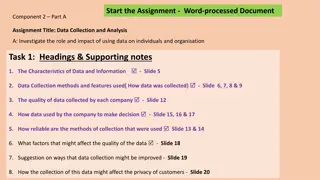Understanding Data Linkages for DaVINCI
Explore the intricacies of patient identifier linkages and linking methodologies for direct care data in the context of DaVINCI. Learn about different systems such as CHCS, AHLTA/CDR, MHS Genesis, and how they utilize identifiers like EDIPN, SSN, and more to establish unique patient records. Discover the crosswalk of person identifiers used to combine records for DaVINCI. Delve into the CHCS-based linkages and their unique record identification approach.
Download Presentation

Please find below an Image/Link to download the presentation.
The content on the website is provided AS IS for your information and personal use only. It may not be sold, licensed, or shared on other websites without obtaining consent from the author. Download presentation by click this link. If you encounter any issues during the download, it is possible that the publisher has removed the file from their server.
E N D
Presentation Transcript
Data Linkages for DaVINCI
Objectives Describe patient identifier linkages. Identify linking methodologies for direct care data. Describe
Patient Linkages While the EDIPN is the official identifier for DoD beneficiaries, there are systems that were not built to rely upon EDIPN. CHCS uses the CHCS Host + Patient IEN. This is the only patient identifier that is always populated in CHCS data. This field is not available outside of CHCS. CHCS also has an EDIPN and an SSN when the patient has one.. AHLTA/CDR uses the CDR Unit ID. This is based off of Sponsor Social SSN and the patient s relationship to sponsor. This field is corrupt; it not unique. This is the only field that is always populated in AHLTA/CDR AHLTA/CDR has an EDIPN but is also corrupt. Usually only one of a person s duplicate CDR Unit IDs will have the EDIPN. SSN is also available, if the patient has one.
Patient Linkages Newer systems are usually built with EDIPN as the foundational person identifier. Source DEERS Primary Identifier EDIPN CHCS Host + Patient IEN; not available outside of CHSC CDR Unit ID (corrupt) EDIPN EDIPN MRN, Person Key Other Identifiers SSN also comes in feed, where available CHCS AHLTA PDTS TED MHS-Genesis EDIPN, SSN, Sponsor SSN, FMP EDIPN (corrupt), SSN, where available SSN added in processing. SSN EDIPN and SSN added in processing
Patient Linkages MHS Genesis and Patient Identifiers During registration, MHS Genesis assigns person identifiers. Data are exchanged with DEERS so that EDIPN can be provided. MHS Genesis is built around the person key. There is a person table that contains the person key and maps to EDIPN and SSN. (Be sure you have a good policy on how test persons will be entered into the system prior to implementation) In MHS Genesis, this file is updated whenever a patient has an encounter. Attributes of a patient can be stale in the person file. The MHS uses DEERS to enhance the data provided from Genesis.
Patient Linkages There is a DoD VA person identifier crosswalk that is used to combine records for DaVINCI. EDIPN Patient ICN OMOP Person ID
CHCS-Based Linkages Each CHCS Host uses sequential counters to identify individual records. CHCS Host + Sequential Counter = Unique identifier for a record Two very important record IDs are the: Appointment ID Number: Uniquely identifies a professional encounter record. Patient Registry Number: Uniquely identifies an inpatient admission record. CHCS links events associated with an encounter or an inpatient admission with these identifiers. Lab Rad Pharmacy Referral Vitals Appointments Enables analysts to track services associated with a visit or a stay
CHCS CHCS Appt file entry Mom makes appointment Example: Data files prepared from operational process CAPER Provider sees patient Provider orders ancillaries and documents care Lab Rad Information in CHCS is generally collected in the course of doing business Rx
Direct Care Linking Matrix File SIDR CAPER Ancillary PDTS Referral Inpatient N/A MTF + PRN ORDDMIS + PRN N/A N/A Professional DMISID + Appt ID No N/A ORDDMIS + APPTNO ORDDMIS + APPTIEN APPTDMISID + APPTIEN
Ambulatory Events Linking CAPERs to Other Services General approach to retrieving CAPERs and related services: Retrieve CAPERs of interest, including Tmt DMIS ID and Appointment IEN. Query ancillary data for matching records, including only records where the Ordering DMIS ID (orddmis) and Appt record ID (apptno) from ancillary match the Tmt DMIS ID (dmisid) and appointment ID number (apptidno) from CAPER Ancillary CAPER Ordering Site Appointment Record ID Tmt DMIS ID Record ID =
Ambulatory Events Linking CAPER to Labs Appointment Record ID = Appt IEN where lab was ordered Record ID = Appt IEN
Example of Linked Data Newborn at an MTF SIDR MSDRG Description Admission Date Disposition Date 792 NEONATE, BIRTHWT >2499G, W/O SIGNIF O.R. PROC, W OTHER PROB 4/5/16 4/6/16 CAPER DX1 Description CPT_4 Description MEPRS Code Description Encounter Date Z3800 SINGLE LIVEBORN INFANT, DELIVERED VAGINALLY 54150 CIRCUMCISION, CLAMP/DEVICE/RING BLOCK AGHA FAMILY PRACTICE NEWBORN NURSERY 4/6/16
Example of Linked Data Linked Labs Emergency Room Visit at an MTF CAPER Linked Rads
CDR Linkages Besides linking the CDR data to other MTF files, there are various linkages between the CDR data types Two main helper files are the CDR Patient and CDR Appointment files which allow CDR data to be linked to data from CHCS and other systems The Patient file can be merged by the Unit Number, called CDR_PATIENT_ID in the MDR For the most part, this merge has already been done in the files available in MDR PUB There are lots of complicated linkages within the CDR, but in the MDR, most of the linking has already been done for you
CDR Linkages All three lab files (Chemistry, Microbiology, Pathology) have a LAB_ORDER_ID, but information from the CDR Lab Orders file has already been appended to these files Microbiology can be linked to the Susceptibility results using the MICRO_EVENT_ID Pathology can be linked to additional CPT codes using the PATH_EVENT_ID Medication Orders and Fills can be linked using the MED_ORDER_ID There is also a CDR_PROVIDER_ID on many of the files, but it does not link to anything
Example of Linked Data Metabolic Panel and Other Labs Ancillary File Chemistry Results Lab Test Name Result LOINC Result LOINC Name Result Numeric Result Text CPT Description ALBUMIN:MCNC:PT:SER/PLAS:QN: CMP W/GFR CMP W/GFR CMP W/GFR CMP W/GFR CMP W/GFR CARDIAC PANEL 2157-6 CARDIAC PANEL 13969-1 CARDIAC PANEL 20569-0 1751-7 1975-2 17861-6 2028-9 2075-0 2.8 0.2 8.2 27 100 341 1.4 0.4 2.8 0.2 8.2 27 100 341 1.4 0.4 BILIRUBIN:MCNC:PT:SER/PLAS:QN: 82040 ASSAY OF ADP & AMP CALCIUM:MCNC:PT:SER/PLAS:QN: 82247 BILIRUBIN, TOTAL CARBON DIOXIDE:SCNC:PT:SER/PLAS:QN: 82310 ASSAY OF CALCIUM CHLORIDE:SCNC:PT:SER/PLAS:QN: 82374 ASSAY, BLOOD CARBON DIOXIDE CREATINE KINASE:CCNC:PT:SER/PLAS:QN: CREATINE KINASE.MB:MCNC:PT:SER/PLAS:QN: 82435 ASSAY OF BLOOD CHLORIDE CREATINE KINASE.MB/CREATINE KINASE.TOTAL:CFR:PT:SER/PLAS:QN: CREATININE:MCNC:PT:SER/PLAS:QN: 82550 ASSAY OF CK (CPK) CMP W/GFR CMP W/GFR MAGNESIUM CMP W/GFR 2160-0 2345-7 19123-9 6768-6 2.1 218 2.4 74 2.1 218 2.4 74 82553 CREATINE, MB FRACTION GLUCOSE:MCNC:PT:SER/PLAS:QN: 82565 ASSAY OF CREATININE MAGNESIUM:MCNC:PT:SER/PLAS:QN: 82947 GLUCOSE; QUANTITATIVE, BLOOD ALKALINE PHOSPHATASE:CCNC:PT:SER/PLAS:QN: 83735 ASSAY OF MAGNESIUM PHOSPHATE:MCNC:PT:SER/PLAS:QN: PHOSPHORUS CMP W/GFR CMP W/GFR CMP W/GFR CMP W/GFR 2777-1 2823-3 2885-2 2951-2 1920-8 3.2 4.7 6 133 33 3.2 4.7 6 133 33 84075 ASSAY ALKALINE PHOSPHATASE POTASSIUM:SCNC:PT:SER/PLAS:QN: PROTEIN:MCNC:PT:SER/PLAS:QN: 84100 ASSAY OF PHOSPHORUS SODIUM:SCNC:PT:SER/PLAS:QN: 84132 ASSAY OF SERUM POTASSIUM ASPARTATE AMINOTRANSFERASE:CCNC:PT:SER/PLAS:QN: ALANINE AMINOTRANSFERASE:CCNC:PT:SER/PLAS:QN: 84155 ASSAY OF PROTEIN, SERUM CMP W/GFR 1742-6 44 44 84295 ASSAY OF SERUM SODIUM 84450 TRANSFERASE (AST) (SGOT) TROPONIN I.CARDIAC:MCNC:PT:SER/PLAS:QN: CARDIAC PANEL 10839-9 CMP W/GFR CMP W/GFR . 35 16.7 <0.015 35 16.7 84460 ALANINE AMINO (ALT) (SGPT) UREA NITROGEN:MCNC:PT:SER/PLAS:QN: 3094-0 3097-3 UREA NITROGEN/CREATININE:MCRTO:PT:SER/PLAS:QN: 84484 ASSAY OF TROPONIN, QUANT 84520 ASSAY OF UREA NITROGEN ANION GAP 4:SCNC:PT:SER/PLAS:QN: CMP W/GFR CMP W/GFR 1863-0 18182-6 11 11 281 OSMOLALITY:OSMOL:PT:SER/PLAS:QN:CALCULATED 281 GLOMERULAR FILTRATION RATE/1.73 SQ M.PREDICTED:ARVRAT:PT:SER/PLAS:QN:C CMP W/GFR 33914-3 25 25
Example of Linked Data Urinalysis Ancillary File CPT Description 81001 URINALYSIS, AUTO W/SCOPE Chemistry Results Lab Test Name Result LOINC Result LOINC Name Result Name HDD Result Numeric Result Text PH:LSCNC:PT:URINE:QN:TEST STRIP SPECIFIC GRAVITY:RDEN:PT:URINE:QN: BACTERIA:ACNC:PT:URINE SED:ORD:MICROSCOPY.LIGHT BACTERIA COLOR:TYPE:PT:URINE:NOM: GLUCOSE:MCNC:PT:URINE:QN:TEST STRIP KETONES:MCNC:PT:URINE:QN:TEST STRIP LEUKOCYTE ESTERASE:ACNC:PT:URINE:ORD:TEST STRIP PROTEIN:MCNC:PT:URINE:QN:TEST STRIP NITRITE:ACNC:PT:URINE:ORD:TEST STRIP EPITHELIAL CELLS.SQUAMOUS:NARIC:PT:URINE SED:QN:MICROSCOPY.LIGHT.HPF URINALYSIS W/MICROSCOPIC 5803-2 URINALYSIS W/MICROSCOPIC 2965-2 URINALYSIS W/MICROSCOPIC 25145-4 URINALYSIS W/MICROSCOPIC 5778-6 URINALYSIS W/MICROSCOPIC 5792-7 URINALYSIS W/MICROSCOPIC 5797-6 URINALYSIS W/MICROSCOPIC 5799-2 URINALYSIS W/MICROSCOPIC 5804-0 URINALYSIS W/MICROSCOPIC 5802-4 URINALYSIS W/MICROSCOPIC 11277-1 PH SPECIFIC GRAVITY 5.5 1.012 . . . . 5.5 1.012 NONE LIGHT-YELLOW NEGATIVE NEGATIVE NEGATIVE NEGATIVE NEGATIVE NONE COLOR GLUCOSE KETONES LEUKOCYTE ESTERASE . PROTEIN NITRITE EPITHELIAL CELLS SQUAMOUS RBC . . . ERYTHROCYTES:NARIC:PT:URINE SED:QN:MICROSCOPY.LIGHT.HPF LEUKOCYTES:NARIC:PT:URINE SED:QN:MICROSCOPY.LIGHT.HPF BILIRUBIN:MCNC:PT:URINE:QN:TEST STRIP UROBILINOGEN:MCNC:PT:URINE:QN:TEST STRIP CLARITY:TYPE:PT:URINE:NOM: URINALYSIS W/MICROSCOPIC 13945-1 1 1 URINALYSIS W/MICROSCOPIC 5821-4 WBC . <1 URINALYSIS W/MICROSCOPIC 20505-4 URINALYSIS W/MICROSCOPIC 20405-7 URINALYSIS W/MICROSCOPIC 32167-9 URINALYSIS W/MICROSCOPIC BILIRUBIN UROBILINOGEN CLARITY BLOOD . . . . NEGATIVE <2.0 CLEAR NEGATIVE
Example of Linked Data Chest X-Ray Ancillary File CPT Description 71010 CHEST X-RAY Radiology Results Rad Type Result Text CHEST (PA VIEW) SERIES REPORT PA CHEST ^COMPARISON: NONE AVAILABLE ^FINDINGS: THE LUNGS AND PLEURAL ARE CLEAR. THE HEART, MEDIASTINUM, AND BONY THORAX ARE A (truncated)
Example of Linked Data Visit to Primary Care Clinic for Anxiety CAPER DX1 Description CPT_4 Description MEPRS Code Encounter Date F419 ANXIETY DISORDER, UNSPECIFIED 90836 PSYCHOTHERA,45MIN, PAT&/FAM,E&M BHA2 2/15/16 Vitals Temperature ( F) Height (in.) Weight (lbs.) Systolic BP (mm Hg) Diastolic BP (mm Hg) Heart Rate (/min.) Appointment Date 98.0 64 133 115 77 73 2/15/16 PDTS Product Name (use) NDC Product Strength Days Supply Date Dispensed EFFEXOR XR (antidepressant) BUSPIRONE HCL (anti-anxiety) PROPRANOLOL HCL (beta blocker) 00591555510 00008083302 00378115005 75 MG 10 MG 20 MG 45 30 45 2/15/16 2/15/16 2/15/16 CDR Medication Orders NDC Give Amount Units Duration Medication Order Date Order ID 00008083302 00378115005 00591555510 75 10 20 MG MG MG 45 30 45 2/15/16 2/15/16 2/15/16 XXX YYY ZZZ CDR Medication Fills Order ID Dispense Date XXX YYY ZZZ 2/15/16 2/15/16 2/15/16
Purchased Care Purchased care records come in as claims. When more than one provider of care is involved in an event, each provider is paid separately and there is no indication that the claims when together to form an event. Building episodes of care is an art rather than a science. The only episode building the MHS does is inpatient acute care episodes.
Inpatient Purchased Care Purchased Care: Data element Admitting TED Number can be used to link all claims related to an acute care stay TED Institutional contains the facility bill(s) There can be more than one record per stay. Rare with acute care. Diagnosis, procedures, etc. from hospital perspective. TEDNon-Institutional contains other bills. Lab and pharmacy information usually N/A because part of DRG payments. Admitting TED Number contains the TED Number of the admission record.
Caveats Sometimes an acute stay will have a non-acute component to it. The Admitting TED Number will not incorporate that part of a stay. Example: Patient is treated for a stroke, then goes to a rehab facility. This information could be obtained by retrieving records for persons with inpatient stays beyond the period of stay. There are also entirely non-acute stays which the admitting TED number does not address. i.e. mental health institutions Resource Sharing stays are not included. For those, there will be an institutional TED record but a CAPER to indicate the professional service.























